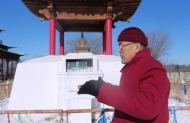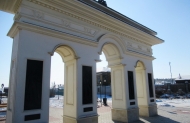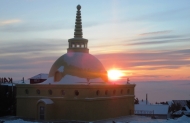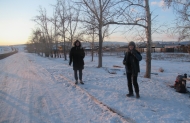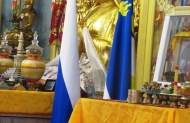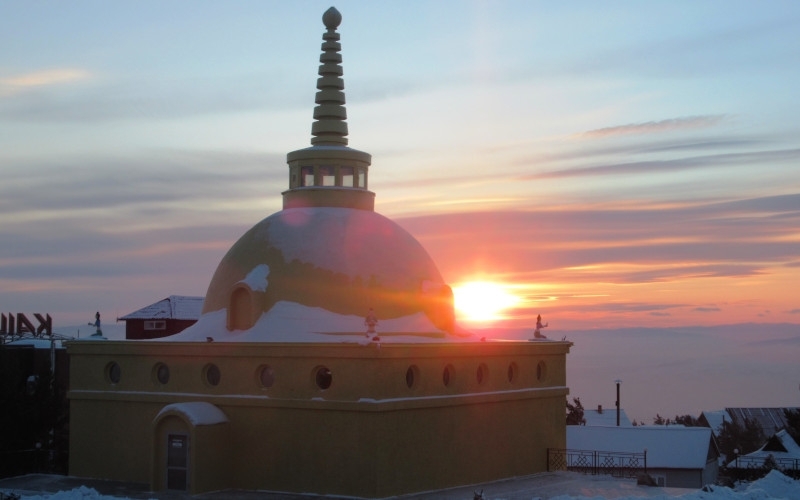
Member of the Eurasian Peoples’ Assembly, Head of the Eurasian Belt and Road project, Doctor of Historical Sciences, Professor of the Educational and Scientific Center for Social Anthropology of the Russian State University for the Humanities Maxim Mikhalev, together with his students, members of the Dorjiev Society of Ethnogeopolitics, of which he is also the scientific director, made a winter expedition trip to the Republic of Buryatia.
The purpose of this research trip, which lasted almost three weeks, from January 30 to February 20, 2022, was to collect primary information for further analysis of the historical role of representatives of the Buryat people in protecting the borders of Russia and in its foreign policy activities in the eastern direction. The study was conducted within the Program of Fundamental and Applied Scientific Research of the Ministry of Education, dedicated to the study of the ethno-cultural diversity of the Russian Federation.
Of particular interest to researchers was the phenomenon of the "Buryat Cossacks" in the context of its mission to protect the borders with China and Mongolia. As it turned out, the fact of the existence of Buddhist Cossacks in Buryatia, little known to the general public, is now regaining relevance in connection with the processes of the revival of the Cossacks taking place here and the search for identity that accompanies them in new historical conditions.
Thanks to the assistance of the Eurasian Peoples’ Assembly and its regional partners, the expedition’s stay program turned out to be rich and fruitful, and they managed to meet and interview Bair Batomunkuev, the only military lama in Russia, and also visit a special Cossack datsan, the parishioners of which belonged precisely to this class. Despite the fact that the process of revival does not always go smoothly, which is associated with the stereotypical perception of the Cossacks as a homogeneous group, the Buddhist Cossacks are optimistic about the future and, like their ancestors, are ready to guard the interests of the Russian state together with representatives of other faiths.
Another issue that was in the focus of attention of the expedition participants was the fate of the Buryats, who served as guides to the great geographical expeditions in Central Asia, led by the famous Russian travelers Przhevalsky, Kozlov and Roborovsky, as well as expeditions in the same areas by the famous Swedish explorer Sven Hedin. While the contribution of these scientists themselves to the development of our ideas about the vast spaces located in the very depths of the continent is undeniable, the role of guides from among the local population is much less illuminated. And this is despite the fact that at one time their contribution to the success of the common cause was noted by the Russian Geographical Society and the King of Sweden. The participants of the current expedition, who visited the frontier Kyakhta region of the republic, managed not only to work with archival and museum documents on this topic, but also to find and interview the direct descendants of the guides. As a result, the idea was born to create a documentary film dedicated to the Buryats who participated in the great geographical expeditions.
Members of the Dorzhiev Society of Ethnogeopolitics, named after the outstanding public and religious figure, teacher of the 13th Dalai Lama and the official representative of Tibet in Russia, the reformer of Buddhism Agvan Dorzhiev, could not miss the opportunity to pay tribute to the memory of this extraordinary person. The plans of the expedition members included visiting places in the Khorinsky and Zaigraevsky districts of the republic associated with the early years of his life, as well as assessing the relevance of his vast legacy at the present time, especially from the point of view of the prospects for establishing cross-border ties through public diplomacy. Being, on the one hand, a representative of the Buddhist world of East and Central Asia, on the other hand, a loyal subject of the Russian Empire, Agvan Dorzhiev managed almost single-handedly to achieve an unprecedented rapprochement between such culturally and geographically distant regions as Tibet and Russia. Despite the fact that the geopolitical situation at the beginning of the 20th century did not generally contribute to the success of his mission, the activities of this, without exaggeration, the great representative of the Buryat people, up to the present time, serve as an excellent example of people's diplomacy, and the circumstances of his life still arouse genuine interest among researchers.
As a result, the trip turned out to be so full of interesting meetings and unexpected observations that at the end of it, the members of the research team were unanimous: another longer expedition to the Republic of Buryatia is required, which is also expected to take place in close cooperation with the Eurasian Peoples' Assembly.




